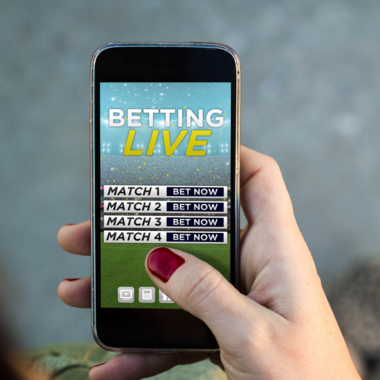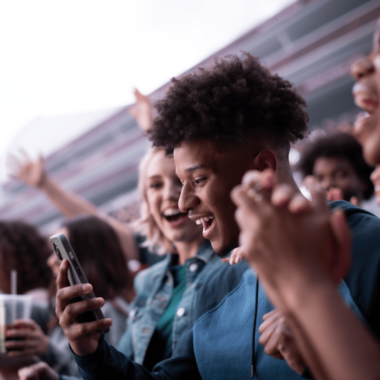
- Five minutes read
Will second screening become the norm for sports fans?
As professional baseball and basketball makes its return in the US, we ask what role second screening can play in televised sport's evolution, and how sports betting operators can benefit from this.
Providing sports fans with a dynamic second screen experience that complements the way they usually watch is not a new concept, but we may be on the cusp of game-changing evolution due to enhancements in technology and social factors.
The most recent showcase of the potential value of second screening was the NFL Draft, held in April, where the league’s 32 teams selected a fresh crop of players to join their respective rosters.
The draft was forced to take on a different look in response to COVID-19, becoming a “virtual draft” instead of the regular in-person event. The unprecedented format afforded an array of second screen experiences alongside the main televised show, as players, pundits, and fans did their best to make the remote event a memorable one. The most ambitious of these was the NFL’s Draft-A-Thon, which brought together several prominent athletes and entertainers to raise money for COVID-19 relief. A record 15.6 million viewers tuned in to watch the draft coverage, and much of this sustained viewership can be attributed to the second screening activity.
And now, after months of waiting, millions of fans, along with stakeholders from a broad range of industries, are preparing to welcome the return of North America’s “Big Four” sports leagues (i.e. the NFL, NBA, MLB and NHL), albeit in a context unlike anything seen before.
A chance for sports betting operators to take the lead with second screening
Of notable interest will be the response of the regulated US sports betting market, which has the potential to grow exponentially in an environment where fans desire more interactive experiences. Second screening will be among the most important tools in crafting those experiences, driving increased engagement through enhanced in-play betting opportunities.
Growing popularity for second screening, particularly among younger demographics of sports fans, was evidenced in 2019 research from leading video management platform Imagen. According to the research, 78% of millennial and Gen Z fans enhance their live viewing experience with non-game content by dual screening, while 39% of millennials are willing to pay for exclusive online sports content.
To assess how second screening fits into the larger picture, it is crucial to understand the mounting strength of the US sports betting market, which is evidenced in both revenue figures and legislative momentum.
According to the American Gaming Association (AGA), US bettors legally wagered $13 billion in 2019, nearly doubling the $6.6 billion handle from 2018. The biggest drivers of this success were Nevada ($5.3 billion) and New Jersey ($4.6 billion). From a legislative perspective, there are presently 18 states with legalized sports betting, while another four, along with the District of Columbia, have recently passed bills. A further 25 states have introduced bills that have not been passed into law.
The momentum of the industry growth being driven by regulation provides the incentive needed to drive innovation that can deliver timely and actionable metrics, especially when it comes to supporting in-play sports betting.
Young players want more information when sports betting
To find out more about US consumers’ attitudes to mobile sports betting, Paysafe’s February 2020 report, The Evolution of Mobile Sports Betting, asked respondents about their greatest concerns with wagering online. One of the more popular answers (19%) among those in the US was “not having enough information to make an informed bet”. Apart from “I prefer to concentrate on the games as a fan” (26%) it was the most popular response from those under 35 years old (21%).
The importance of catering to the demands of that younger demographic are highlighted in the AGA’s 2019 Sports Betting Consumer Study, which found that 45% of core bettors are 23-34 years old. Also significant was the study’s finding that the core bettor demographic is far more engaged on social media than either casual or potential sports bettors.
When factoring in the demand for fresh sports content, long-term market outlook, demographic trends and a desire for more comprehensive data, any operator considering a launch or expansion in the US will need to leverage the inherent benefits of second screening to build its player base.
5G brings further opportunities
While many leagues and networks already feature programming specifically tailored to those desiring greater data-driven analysis, sports betting operators can be equally influential in commanding attention through second screen content. Not only is it reasonable to expect this demand to be heightened following an extended period of isolation, but it also corresponds with the continued emergence of 5G technology. Additional Paysafe research found that 66% of all sports bettors across all markets surveyed planned to do more sports betting with the introduction of 5G.
The ability of 5G technology to take second screen experiences to the next level is undeniable. Increased speed and connectivity will ensure bettors receive the most relevant and up-to-date metrics to help them make informed split-second decisions regarding in-play bets and other wagers.
In the long-term, 5G’s role could also extend to helping augmented reality (AR) play a bigger role in online sports betting, perhaps significantly altering the level of engagement and insight that fans come to expect from their viewing experience. However, as second screening is only just now on the brink of achieving its full potential, AR will require continued development and experimentation before realizing its own game-changing moment.
As stakeholders prepare for a new era in professional sports brimming with potential for evolution, it will be exciting to see what experiences the future holds in store for second screening. With the US sports betting market poised for long-term growth, the industry’s most creative and forward-thinking stakeholders will strive to create solutions that can provide dynamic viewing experiences, while generating increased revenue.




